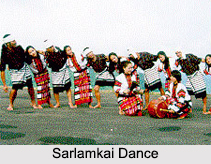 Folk dances of Mizoram include Khallam, Chailam, Chawnglaizawn, Chheihlam, Thanglam, Zangtalam and Cheraw. These dances express the carefree spirit of the Mizos. These dances are performed during festivals. Drum and gong are the main instruments which are used during their dances.
Folk dances of Mizoram include Khallam, Chailam, Chawnglaizawn, Chheihlam, Thanglam, Zangtalam and Cheraw. These dances express the carefree spirit of the Mizos. These dances are performed during festivals. Drum and gong are the main instruments which are used during their dances.
Folk Dances of Mizoram reveal the cultural liveliness of the place. Deriving encouragement from the natural beauty of the hilly lands, the Folk dances of Mizoram are identical to the multi-cultural atmosphere of Mizoram.
Different Folk Dances of Mizoram
Following are the Different Folk Dances of Mizoram:
Cheraw Dance: Cheraw dance is also known as `Bamboo dance` as bamboos are used while performing the dance. This dance is one of the most colourful and distinct dance of the Mizos. It is thought that the dance had previously subsisted way back in the 1st Century A.D. Men sit head to head on the ground, tap long pairs of horizontal and cross bamboo staves open and close in rhythmic beats. Girls wear multi-coloured Mizo costumes of `Puanchei`, `Kawrchei`. "Vakiria" and `Thihna` dance in and out between the beats of bamboo. This dance is performed in almost all celebratory occasions.
Khuallam Dance: Khuallam is also known as `dance of the guests` and it is performed at the time of ceremony called `Khuangchawi`. In this dance a group of males perform to the tunes of drum and gong. Khuallam dance is performed in the ritual called "Khuangchawi".
 Chheih Lam Dance: This dance represents spirit of happiness and joy. This dance is executed with song which is sung with bamboo tube and drum beats. The dancer is surrounded by people sitting in a circle around him. Finally, the dancer is joined by those circling him. It is performed to signify the end of a day"s work.
Chheih Lam Dance: This dance represents spirit of happiness and joy. This dance is executed with song which is sung with bamboo tube and drum beats. The dancer is surrounded by people sitting in a circle around him. Finally, the dancer is joined by those circling him. It is performed to signify the end of a day"s work.
Sawlakia Dance: Sawlakia was presented previously to celebrate winning a war. It evokes actions of a hero who has won the war. As women and men stand in their places, the hero dances holding shield and sword to the tune of gong beats. This is one of the earliest and traditional dances celebrated by people of Mizoram.
Chailam Dance: This dance is performed during the festival of Chapchar Kut. This dance is performed by men and women standing in circles. Women and men stand one after another and together form a circle. They hold each other by shoulders and waists and they sing a song in chorus and dance while swinging to its rhythms. Drums and gongs are also used.
Chawnglaizawn Dance: This is a popular folk dance of the Mizo community people known as Pawi. It is presented by a husband to weep for the death of his wife. The husband would be constantly performing this dance till he gets tired. Chawnglaizawn is performed on festivals and also to celebrate trophies brought home by winning hunters.
Tlanglam Dance: Tlanglam is performed in the length and breadth of this State. Using music of Puma Zai, there have been a number of variations of the dance. This dance is one of the most popular dances these days by cultural troupes in various places. Both sexes take part in this dance.
Zangtalam Dance: Zangtalam is a popular Paihte dance performed by men and women. As dancing, the dancers sing open song. A drummer is a head and director of the dance. The period of the dance depends on the drummer.
Par Lam Dance: In this dance, female dancers wear multi-coloured clothing and tuck flowers in their hair. They dance to the tunes of songs which are sung by them. They also wave their hands while dancing elegantly. A couple of men play guitars to supply background music to the dance.
Sarlamkai Dance: It is a soldier dance performed to rejoice a victory in war. Songs are not sung; only gongs or cymbals or drums are used for making beats. In the dance, boys and girls standing in alternate position, dance in circles.




